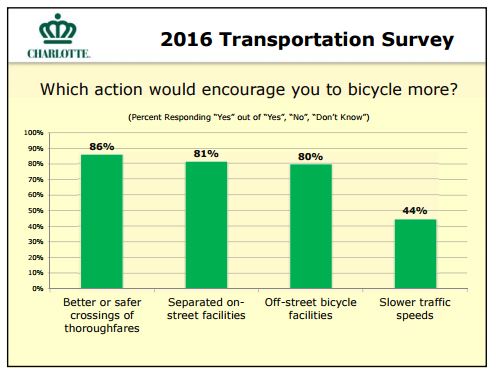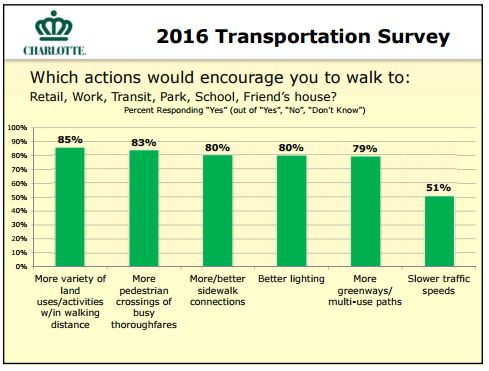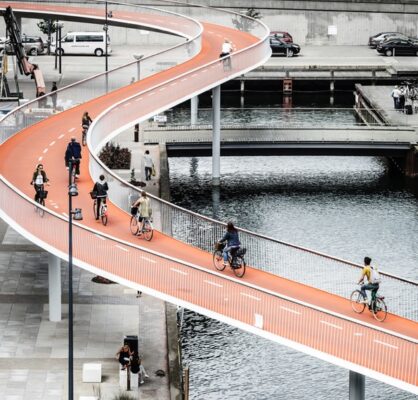Will Charlotte’s transportation network be ready for 400,000 new residents?
Written by Jordan Moore and Meg Fencil
Between 2015 and 2040, Charlotte’s population is projected to grow by 400,000 people. That’s like adding the entire population of Miami or New Orleans to our existing city! Will our street network be ready to safely and equitably provide for the daily transportation needs of our current and new residents?
That was the question on the mind of City Council’s Transportation and Planning Focus Area at their September 12 meeting. Click here for the presentation they saw.
It’s exciting to be one of the nation’s fastest growing large cities, but it’s also quite a challenge to plan for such incredible population growth. We’re glad to see our City Council’s Transportation & Planning Focus Area and Charlotte Department of Transportation developing a clearer picture of upcoming transportation needs as well as developing a budget and plan to meet those needs.
The results of CDOT’s 2016 Household Survey are in, and residents are speaking up for safer bicycle and pedestrian infrastructure. 81% of respondents would be encouraged to bicycle more if they had on-street separated facilities (ie, protected bike lanes or cycletracks) available.

People would walk more if it was safer, more convenient, and allowed them to access a variety of interesting and useful destinations:

Charlotte’s Transportation Action Plan (TAP), the policy and technical document that helps Charlotte achieve its transportation vision, is updated every 5 years and adopted by City Council. The 2011 TAP is due for an update this year. The necessary updates are determined by the results of the Household Transportation Survey, best practices in other cities, and needs that are seen by CDOT and City Council since the adoption of the previous TAP.
The emphatic key point of the presentation was: “To build, maintain, and operate a travel network with safe options for pedestrians, bicyclists, transit riders, and motorists in our rapidly growing City, staff estimates $5 Billion in transportation investments will be needed over the next 25 years.” Here’s a breakdown of the proposed investments:
- $665M for maintenance: 12 year re-surfacing cycle; 160 miles of sidewalk; 100 miles of curb and gutter
- $285M for technology: new equipment at intersections’ Traffic Management Center improvements’ signs and markings; Intelligent Transportation Systems; new street lights
- $130M for safety: 40 projects to improve safety for bicyclists, pedestrians, and motorists; embrace Vision Zero philosophy through engineering, education, and enforcement to reduce fatal crashes and serious injuries
- $3B for Complete Streets: 100 multi-modal arterial roadway projects and 40 intersections; more frequent bridge inspections and replacements; 200 smaller-scale projects
- $400M for walkability: 250 miles of new sidewalks; projects at 20 schools; 250 crossings at arterials (major roads); ADA retrofit projects (to improve accessibility)
- $100M for bicycle travel: 250 miles of new bikeways including buffered bike lanes and off-street paths; 80 low-cost bike-ped connections
- $330M for placemaking: station area projects in 2 rapid transit corridors; projects in 5 mixed-use activity centers; 100-150 traffic calming projects; 20-25 landscape/pedscape projects; 20 area plan project
- $195M to preserve opportunities: design/engineering for selected future projects; advance acquisition to preserve parcels for right-of-way; leverage funds with private developers to create better projects and travel networks
We’re particularly excited by CDOT’s clear articulation of what transportation customers want: Better mobility, more mode choices, more route choices, better designs, and safer streets.
A lot of great additional policies are recommended for the TAP that weren’t included in the 2011 adopted version, including (in part):
- Establish mode share goals. This means goals will be set for what percent of trips are taken by single occupancy vehicle trips, car/vanpool, bicycle, walking, and transit. With the projected increase of 1.5 million daily trips by 2040, it’s simply not sustainable for a large percent of those trips to be taken by single occupants of cars!
- Refer to latest NACTO design guidance: Our Bicycle Program Director is in Seattle right now for the 2016 NACTO Designing Cities conference, where he’s learning the most current and effective practices for multi-modal transportation planning and implementation. We’re glad CDOT and City Council are pursuing best practices for our transportation networks!
- Plan and design for the “8-80” City: Simply put, a city whose streets are safe and inviting for both an 8 year-old and an 80 year-old has designed its transportation network properly. Charlotte still has a lot of work to do to correct decades of past decades of planning solely for automobiles, but we’re now heading in the right direction by considering the needs of all street users!
- Emphasize safety through Vision Zero: It’s time to stop just aiming to reduce accident rates. It’s time to aspire to end traffic fatalities and serious injuries.
- Refer to the Comprehensive Transportation Plan (CTP): The CTP is a state-mandated transportation plan for the Charlotte Regional Transportation Planning Organization (CRTPO) that includes Mecklenburg, Union (NC), and southern Iredell Counties. Think of it as the larger regional context for CDOT’s work. As Charlotte grows, the integration of our transportation networks with the networks of our neighboring communities will become even more critical to move people safely and efficiently across the region.
Here’s how City Council’s Transportation and Planning Focus Area members responded to the presentation:
The question was raised by Mr. Smith as to whether or not the “Centers, Corridors and Wedges” approach is actually the idea we want to base our entire Transportation and Development Plan around. Mayor Pro Tem Lyles quickly agreed that she also wondered whether or not this was the best foundation on which to build our future.
To entirely understand the strategy, click this link. In short, the thought behind the strategy is that by identifying economic centers that are compact and dense, we can focus our development towards not only the geography but the overall “feel” of places as well. By steering our development towards economic centers, existing neighborhoods can gain access to a greater amount of goods and services while still retaining their historical characteristics. This allows development to happen along specific corridors that will inevitably change our city’s look and feel.
Whether or not this is the right strategy was not resolved. However Norm Steinman, our city’s Planning and Design Division Manager, answered by saying, “We’ll be glad to come back to it, but I believe it is a strong yes. The best transportation strategy is correct land use.”
Mayor Pro Tem Lyles suggested that, “We need to keep economic development connected.”
Our city’s Director of the Transportation Department, Danny Pleasant, added, “(We must) optimize existing structures, but (also) ask if this is the best growth strategy.”
Mr. Steinman stated that we need “NACTO based mode-share goals and better design in our right of way.” He continued to say that we must use the 8/80 principle in our new plan and that we must focus our new development towards Vision Zero goals, an ambitious plan that aims to have NO deaths resulting from automobiles and people walking or biking. He also reiterated that we will see an increase in daily trips in vehicles in our region from 3.2 million to 4.7 million by 2040.
Mr. Autry asked, “Are we trending towards VMT (vehicles miles traveled) in the wrong way?”
Mr. Steinman pointed out that although more trips are being taken, they are are generally shorter trips than in the past. Charlotte as a city is seeing a decrease in VMT.
Mr. Autry followed up by asking, “Is there a tipping point where we won’t be able to build more roads? When will it make more sense to fund more active transportation (projects)?”

“The Snake” – Copenhagen, Denmark
Mr. Steinman responded that the average trip in a vehicle in Charlotte is about 5 miles (very doable by bike), and Mr. Pleasant pointed out that we are starting to see a “rearrangement of land use” and alluded to a large positive economic shift that is likely headed our way. He added, “We can change the trajectory (of Charlotte) by changing the development pattern.”
Mr. Autry, in response, asked, “Can we consider a leap? If we’re really going to focus on active transportation, isn’t it going to take an outrageous investment?” He followed this question up by pointing out that Atlanta, our regional economic rival who already suffers from severe congestion, has just committed $1 billion over the next 25 years to funding bicycle and pedestrian projects.
Mayor Pro Tem Lyles agreed, “That is a great question.”
Mr. Phipps spoke up at this point and noted that we would have to have a great “change in our culture” to see this type of shift.
Mr. Autry pointed out that “this is already happening.”
Deborah Campbell, our city’s Assistant City Manager, reminded the group that we would be facing “an issue of maintenance” and raised the question of future maintenance costs of new infrastructure.
Mr. Autry pointed out that the city of Portland (OR) has saved millions of dollars from their maintenance budget by building bicycle infrastructure. Which is true.
Charlotte expects to pay $665 million over the next 25 years just to maintain our current transportation network.
Mr. Pleasant stated, “The city must go ahead and reserve the right of way (for new projects) now and we must do the funding and acquisition in advance.”
The Transportation and Planning Committee wants to get public input in October in order to make official recommendations by November.
We think that you should get involved. We’ll let you know when and where you can make your voice heard when we learn more about the public input process.
Thanks for reading!
As a nonprofit, community support is essential for us to keep doing what we do — including providing free articles like this. If you found this article helpful, please consider supporting Sustain Charlotte.
Want to stay in the loop? Subscribe to our weekly newsletter and follow us on Instagram, Facebook, and Twitter.
